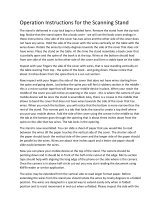
POWIS IMAGE WRAPPER USER’S MANUAL 17
SAFETY & COMFORT
In recent years, medical attention on occupational injuries has identified
common, seemingly harmless activities as potential causes of a wide
range of problems collectively known as Repetitive Stress Injuries or
Cumulative Trauma Disorders. It is now recognized that any repetitive
motion may contribute to these health problems. Depending on how it is
used, the prolonged or repetitive use of almost any machine might have
a potential for discomfort or injury. As a user of this Image Wrapper, you
might also be at risk.
The most commonly accepted causes of this type of disorder are
repeated, forceful actions, usually in an awkward position or posture,
without sufficient rest to allow the body to recover. These repetitive
actions may cause nerves, tendons, ligaments, and other soft body parts
to become irritated and inflamed.
By paying attention to the way you perform your work, and do other
activities, you can identify the behaviors that could put you at risk.
The precautions outlined below are examples you can take to help
reduce the likelihood of developing these problems and work more
comfortably with your new Image Wrapper. Keep in mind, however, that
these are only suggestions. Comfort is personal and only you may be
able to judge what works best for you.
• Youmayndthatyourbodywillbemostcomfortableandrelaxed
with the Image Wrapper placed directly in front of you. The Image
Wrapper and your supplies should be within easy reach — avoid
excessive stretching.
• TheImageWrapperisbestusedinastandingposition.Makesure
that the work surface height that the Image Wrapper is on does not
require you to bend over in a way that would strain your back or
arms.
• Donotbendyourwristsunnaturallyduringuse.
• Don’tstayinonepositionfortoolong.Trychanginghandsand
varying your posture.
• Takebreaks.Frequentshortbreaksareprobablybetterthanafew
long ones.
Many factors go into creating a comfortable workspace, including proper
placement and adjustment of furniture and equipment. A thorough work
site analysis by a qualified expert is important in order to reduce the risk
of repetitive motion injuries. If you experience pain, throbbing, aching,
tingling, stiffness, a burning sensation, swelling, numbness, or weakness in
your wrists, hands, arms or legs, see your physician immediately.
DO NOT IGNORE THESE WARNING SIGNS. Even if symptoms occur
when you are not using the Image Wrapper, they can be associated
with painful and sometimes permanently disabling injuries or disorders
of the nerves, muscles, tendons, or other parts of the body. These
symptoms could mean that you are developing a repetitive stress injury
that requires prompt medical attention. For more detailed information,
consult your doctor.
B


























